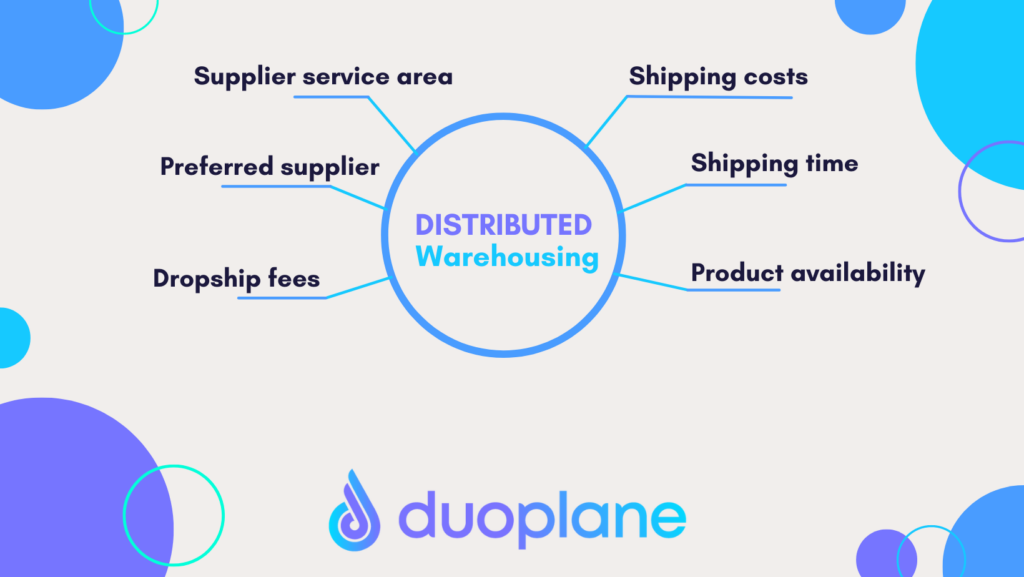April 20th, 2021 | 5 min read

Retailers, it’s 2022 and time to level up your ecommerce operations with distributed warehousing. Whether you believe having distributed warehouses is impossible for your business or managing multiple suppliers for the same product is too time-consuming, we are prepared to show you how strategic warehouse distribution is not only accessible but the key to optimizing your processes.
Many general-purpose software is built under the assumption that one product has one vendor. With Duoplane and other sophisticated solutions, you can fulfill orders for the same product to the lowest cost geographically distributed supplier.
Interested in learning how distributed warehouses can make your operations more efficient? Let’s dive in.
Let’s start with the basics. Distributed warehousing is a business model in which a retailer uses various strategically-placed warehouses to fulfill, ship, and distribute products. Suppliers own the inventory; however, they leverage multiple warehouses to route the product most efficiently.
There are numerous reasons why growing online retailers choose to use redundant fulfillment partners. The most common logic is that distributed warehousing lowers shipping costs. Instead of sending someone in Maine a product from Arizona, you can call upon your warehouse in New Hampshire to distribute the same product for a fraction of the cost and time. In turn, shorter shipping time enhances customer satisfaction.
Similarly, distributed warehouses allow you to take advantage of price competition among suppliers. Ensure you are factoring in both wholesale costs and shipping costs into your overall cost evaluation.
Cost aside; the distributed warehousing model provides a more reliable supply. Should something go wrong with one warehouse, you have others to fall back on. This applies to both dropship suppliers and 3PLs.
Duoplane can automate sending POs, inventory syncing, & shipment feeds. Get in touch with us to start your free trial!

Several variables determine how an order should be routed. Let’s dive into the most common factors to consider:
The most crucial factor to consider when choosing a warehouse is availability. Which vendors have the products in stock? If your lowest-cost provider has no stock, it is pertinent that you select a higher-cost warehouse to ensure your customer gets their product in a reasonable time frame.
Once you identify which redundant fulfillment partners have the item in stock, it is time to see who is the cheapest supplier.
Most of the time, retailers will want to minimize the number of purchase orders created by an order. This reduces the number of shipments and, in turn, shipping costs.
Geographic distance is a significant factor to consider as it affects shipping costs. After all, why would you send someone in California a shipment from New York if your warehouse in Arizona could fulfill the order? Typically businesses calculate the distance using the equation: cost / Km / Kg.
Another geographic factor considered is whether a supplier services the area of the end consumer. For instance, a US-based warehouse may not ship outside the US. Alternatively, if a customer orders restricted goods, like alcohol or fireworks, there may be rules about crossing state lines.
This factor is particularly important for businesses that follow a local delivery model. For example, if you are a florist, you will want to route the order to the shop closest to your customer.
Supplier preference is personal favoritism toward one supplier over another. This typically occurs because one supplier is more reliable or efficient than the other or you. Alternatively, you may prefer one supplier to strengthen the relationship.
When choosing a vendor to fulfill your order, consider how long it takes them to ship an item. You can calculate their average shipping time based on historical performance. Even if the more efficient vendor is not the cheapest, you may benefit from choosing them, as faster ship times improve overall customer satisfaction.
Like any other, it is important to factor drop ship fees into your overall cost. When retailers exclusively look at the item cost, they overlook many additional accompanying fees.
While distributed warehouses are not very complicated to set up with the right system, there are some essential rules of thumb to know before starting.
Notably, there should only be one system making routing decisions. This is to prevent a double shipment or no shipment at all. For example, if Shopify makes routing decisions on top of your outside system, they may choose different vendors to fulfill the orders, causing a double shipment.
Additionally, it is crucial to keep processes as simple as possible. While there is always the temptation to make precise rules and hyper-automize, automated rules can be hard to debug if they become too complicated.
Regarding vendor relationships, it is good to understand that by using redundant fulfillment partners, you risk the possibility of diluting your existing vendor relationships.
We’ve been the industry-leading solution to automate dropshipping operations for over 12 years. Check out our reviews page to learn why our clients love us.

If you manage inventory syncing manually, there is an added time cost to undertake distributed warehousing well. To find the best supplier to route your orders, you will need real-time information about inventory and expenses.
That being said, the most essential thing to have when beginning a distributed warehouse strategy is the right system. Your system should be able to reflect inventory and costs for each supplier accurately.
Additionally, your system should be able to store vendor-specific product information, like unit costs and SKUs, as not all vendors have the same SKU numbers.
Most importantly, your chosen system needs to be able to add additional vendors to each product. Systems that charge a lot to integrate a new vendor should largely be avoided, as multiple vendor functionality is available on most sophisticated systems. Duoplane, for instance, allows users to add a secondary source for every product without the financial burden.
Overall, your system needs to be able to make intelligent routing decisions. This includes complex use cases. For example, some retailers route orders to different warehouses depending on the day of the week to keep all vendor relationships consistent. Other retailers will make their decision strictly based on financial costs. Because there is no “one-size-fits-all” solution, your system needs to be able to handle a variety of scenarios and preferences.
To learn how to set up distributed warehouses in Duoplane, check out our support article here.
This post was last updated on Aug 4, 2023.
Examples of distribution warehouses include the widely recognized Amazon fulfillment centers, Walmart distribution centers, and FedEx hubs. Some other 3PL distribution warehouses include Shipmonk, ShipHype, or Ryder. With over 20,410 3PL logistics businesses in US as of 2023, you can rest assured there will be no shortage of a distribution warehouse to choose from. Check out this article on tips for finding a suitable 3PL for your needs.
The key difference between a storage warehouse and a distribution warehouse lies in product storage duration and purpose. A storage warehouse focuses on long-term storage of products that aren’t in high demand or need preserving for future use. In contrast, a distribution warehouse is for short-term storage, holding products ready for shipping to customers or other destinations.
On a larger scale, setting up a distribution warehouse involves several key considerations such as location, size, layout, equipment, technology, staffing, and processes. You must choose a location that is convenient for your customers and vendors. The size and layout of the warehouse should be determined based on the type, quantity, and frequency of the products you handle. Appropriate equipment and technology need to be chosen to facilitate the movement, storage, packing, and shipping of products. You will also need to hire, train, and manage staff to perform various warehouse tasks. Lastly, designing and implementing efficient processes will optimize the efficiency, accuracy, and quality of your warehouse operations.
On a smaller scale, consider working with a 3PL warehouse rather than setting up a distribution warehouse until you are ready to scale up. This may be more costly over time at the beginning, but the business risk and initial financial commitment is lower.
One of the main advantages of using a distribution center is the potential reduction in delivery times and costs. By storing your products closer to your customers or major transportation routes, you can shorten the distance and time required for delivery. This can improve customer satisfaction and loyalty, as well as save on transportation expenses. Another advantage is the ability to optimize inventory management and supply chain efficiency. By centralizing your storage and shipping, you can better track inventory levels, product flow, and shipping status. This can help prevent issues like stockouts, overstocking, or misplacement of products.
Amazon warehouse distribution refers to the network of warehouses that Amazon uses to store and ship products to customers worldwide. Amazon operates over 175 fulfillment centers, which are large-scale distribution warehouses that process millions of orders each day. In addition to these, Amazon has other types of warehouses, such as sortation centers , delivery stations, and specialized warehouses. Amazon’s distribution network also includes various pick-up points, self-service kiosks, deal-based locations, and delivery options. The Amazon warehouse distribution system is one of the most advanced logistics systems globally, leveraging sophisticated technology such as robotics, artificial intelligence, machine learning, computer vision, cloud computing, and data analytics for optimized operations.
Duoplane is a dropshipping automation software built by dropshippers, for dropshippers. We’re here to help you streamline your ecommerce retail fulfillment operations and automate order routing, inventory syncing, shipment feeds, and more.
Don’t just take our word for it – check out our reviews and case studies to learn why we’ve been the industry-leading solution for over 12 years, assisting over 300 retailers in onboarding over 2000 vendors and 3PL warehouses.
Experience the best dropshipping automation software risk-free with our 14-day free trial. Our dedicated onboarding specialists will guide you through the setup process, ensuring you’re ready to hit the ground running.
IF YOU DROP SHIP,
THEN YOU’LL LOVE DUOPLANE.
Duoplane intelligently and automatically routes orders to the right vendor or warehouse.
Keep everyone on the same page and save time by allowing vendors to manage their orders.
Automate vendor inventory feeds to keep your product catalog accurate.
Stay on top of your books by connecting with your accounting system to sync vendor invoices.
Streamline your operations and centralize orders from all of your e-commerce channels
Manage the full order cycle, including changes, shipments, returns, and order exceptions.
Duoplane connects to your existing systems to minimize manual effort by you or your team.
Provide feedback to vendors using actionable performance metrics.
Curious what Duoplane can do? See for yourself with a free trial.
Get in touch with us today!